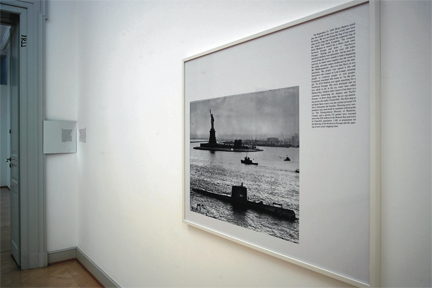| Northwest Passage |
| |

|
| |
| 2005 |
| Digital c-print, image and text |
| |
| On September 11, 1609, Henry Hudson sailed into the mouth of the river that would later bear his name. He was not flying the flag of any nation state on his ship, but instead the corporate flag of the Dutch East India Company. The company hired Hudson to search for a direct trade route between Europe and Asia; a "Northwest Passage." Tasting salt in the river 100 miles upstream Hudson was optimistic, but he soon discovered that the river’s mouth is both a beginning and end. As fresh water empties into the ocean to the south, seawater surges northward up the middle. Muhheakantuck—the river that flows in two directions. The people who named it this call themselves the Lenape or Leni-Lenape, meaning people or common people or real people. Europeans translated this name as "we the people." In 1610 Hudson was again searching for a Northwest Passage. His crew mutinied and set him adrift to die in the icy water later called Hudson Bay. Hudson didn’t know it but there is a waterway connecting the Atlantic and Pacific Oceans—it flows deep under the ice cap stretching across the earth’s North Pole. The first ship to navigate these waters was the nuclear-powered US Navy submarine, the Nautilus. Warming arctic temperatures may soon result in summers without polar ice. The Transportation Ministry of Manitoba, Canada, and a private US partner have invested more than $50 million in the Hudson Bay port town of Churchill, population 1,100, in preparation for the thawing of the Northwest Passage and the opening of new arctic shipping lanes. |
|
| |
| |
| |
| |
| |
| |
| |
| |
| |
| |
| |
| |
| |
| |
| |
| |
| |
| |
| |
| |
| |
| |
| |
| |
| |
| |
| |
| |
| |
| |
| |
| |
| |
| |
| |
| |
| |
| |
| |
| |
| |
| |
|
|
|